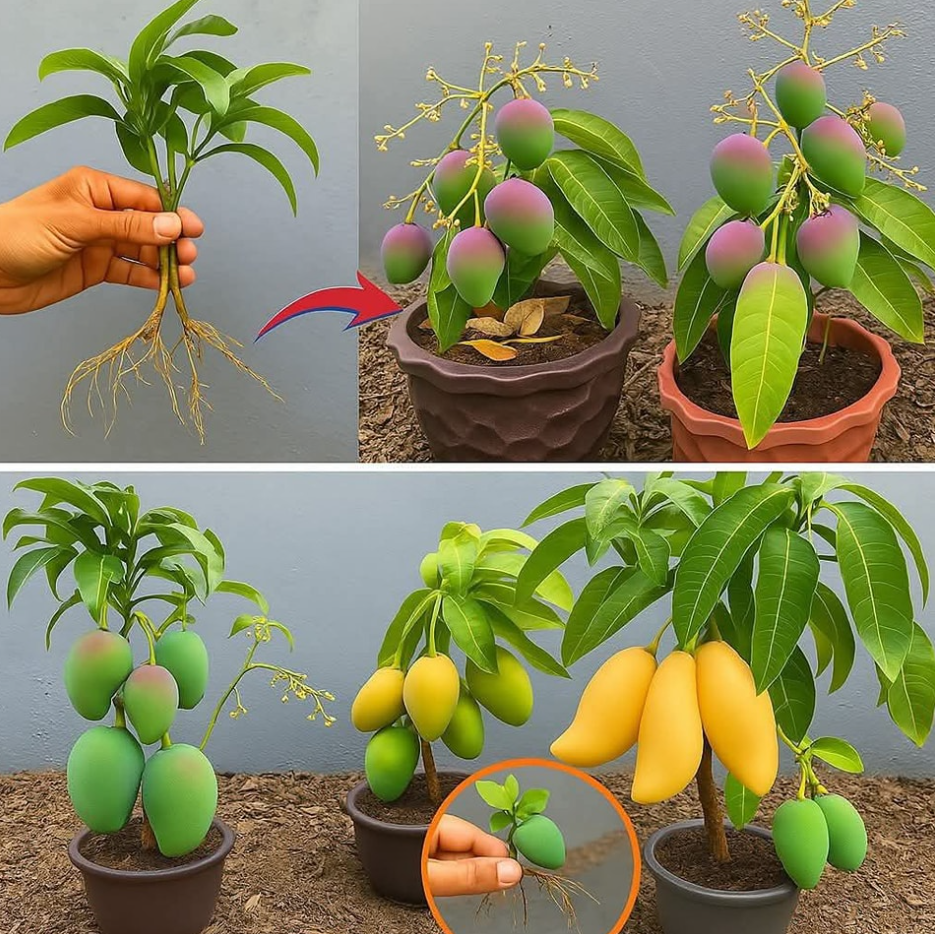-
Healthy mango tree leaves (preferably young, green, and undamaged)
-
Sharp, sterilized pruning scissors
-
Rooting hormone (powder or gel – optional, but recommended)
-
Clean glass or jar of water (or a small pot with moist soil)
-
Transparent plastic bag or humidity dome
-
Potting mix (well-draining)
-
Small nursery pot (with drainage holes)
-
Spray bottle with water
Preparation (Step-by-Step Guide):
-
Select & Cut Leaves
Choose young but mature leaves from a healthy mango tree. Using sterilized scissors, cut the leaf along with a small piece of the stem (petiole). -
Apply Rooting Hormone
Dip the stem end of the leaf in rooting hormone. This step increases the chance of root development. -
Choose a Propagation Method
-
Water Method: Place the leaf’s stem into a glass jar filled with clean, room-temperature water.
-
Soil Method: Stick the stem end about 1 inch deep into moist potting mix in a small pot.
-
-
Create a Humid Environment
Cover the pot or jar with a transparent plastic bag or place it under a humidity dome. This traps moisture and encourages root growth. -
Wait and Monitor
Place the container in a warm, bright area out of direct sunlight. Mist with water daily to maintain humidity. Change the water every 2–3 days if using the water method. -
Root Development
If successful, tiny roots may appear in 3–6 weeks. Once roots are 1–2 inches long, transplant the cutting into a larger pot with rich potting soil.
Serving and Storage Tips (Care Tips for the Growing Plant):
-
Light: Provide bright, indirect light. Avoid harsh direct sun during the early stages.
-
Watering: Keep soil slightly moist but not soggy. Avoid overwatering.
-
Temperature: Mango trees prefer warmth—keep the plant in a room above 20°C (68°F).
-
Pot Upgrade: Once your mango plant becomes stable and taller, repot it into a larger container or plant outdoors in a tropical or subtropical climate.
-
Fertilization: After 8–10 weeks, begin using a balanced, diluted liquid fertilizer monthly.
Variants:
-
From Stem Cuttings: While growing from leaves is experimental, using softwood or semi-hardwood cuttings from a mango tree is more reliable for propagation.
-
Grafting Method: Advanced gardeners often graft mango branches onto rootstock for better fruiting and hardiness.
-
Hydroponic Trial: Try placing leaf stems in a hydroponic medium with nutrients to experiment with soilless growth.
FAQ:
Q1: Can you really grow a mango tree from just a leaf?
It’s rare and experimental. Leaves may sprout roots under perfect conditions, but this method is not guaranteed. Success rates are low, but it’s fun to try.
Q2: How long does it take to see root growth?
Typically between 3 to 6 weeks. Some leaves may never root. Be patient and try several cuttings at once.
Q3: Should I use rooting hormone?
Yes, it significantly improves your chances of root formation, especially with leaf propagation.
Q4: What if my leaf wilts or turns brown?
This may indicate a lack of humidity, too much sun, or an unsuccessful attempt. Try adjusting conditions or testing new leaves.
Q5: When will it bear fruit?
If your plant successfully establishes itself and matures, it may take 4–7 years to bear fruit. Leaf propagation is slow and not commonly used for fruit production.
Disclaimer:
This method is for educational and experimental purposes. Growing mango trees from leaves is not the standard practice and may not always yield results. For reliable fruit-bearing trees, growing from seeds or grafted saplings is recommended.
